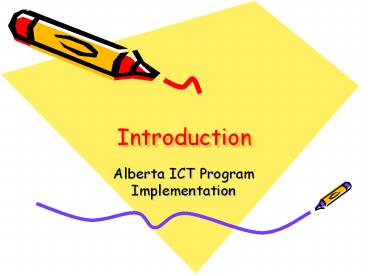Alberta ICT Program Implementation - PowerPoint PPT Presentation
1 / 19
Title:
Alberta ICT Program Implementation
Description:
Progressivism. Pragmatism. Philosophical Language. Foundations of the curriculum. Psychology ... Progressivism Reconstructionism. Society. Barriers to Implementation ... – PowerPoint PPT presentation
Number of Views:41
Avg rating:3.0/5.0
Title: Alberta ICT Program Implementation
1
Introduction
- Alberta ICT Program Implementation
2
Target Groups
- Division 1 grades P-3
- Division 2 grades 4-6
- Division 3 grades 7-9
- Division 4 grades 10-12
3
Foundations of the curriculum
- Philosophy
- Pragmatism
- Progressivism
- Reconstructionism
4
Philosophical Language
Pragmatism Progressivism Reconstructionism
Critically assess information Draw conclusions Alternative viewpoints
Become discerning consumers Solve problems Collaborate
Solve problems Design and create Interact with others
Design and create Technology as it applies to self Moral and ethical approaches
Discriminate between Navigate Technology as it applies to society
5
Foundations of the curriculum
- Psychology
- Behaviourism
- Cognitive
- Humanism
6
Sample outcomes Division 1 C5 - access,
retrieve, and share information from electronic
sources, such as common files Division
2/3 P6 communicate with a targeted audience
within a controlled environment by using
such communication technologies as e-mail
and web browsers. Division 4 P6 select and
use the appropriate technologies to communicate
effectively with a targeted audience.
7
Foundations of the curriculum
- Social Culture
- Technology in our society is developing at a
faster pace necessitating the students ability
to adapt and learn. - Lessons and skills students learn can be used
throughout their personal and professional lives. - The ICT rationale promotes utilizing technology
in effective, efficient and ethical ways
8
Foundations of the curriculum
- History
- From the invention of the printing press until
the 20th century, the technology used in
education was essentially the same. - First uses of modern technologies in education
were in separate skill and trades classes. - Along with the use of technology in trades-based
courses, we are seeing its use in academic
classes with computers and multimedia .
9
Key elements of design
- Subject Centered
- Process design
10
Approach To the Curriculum
- Technical-Scientific Approach
- Tyler Model
11
Barriers to Implementation
Teachers lack confidence in their technological competence
Limited activity ideas for effective use
Availability of technology / Cost
Subject-integration time constraints / Increased workload
Time for training
Saboteurs
Lack of Communication
Unfamiliarity of students and parents
12
Facilitators of Implementation
Board Members
Curriculum Developers
Administrators
Teachers
13
Implementation Plan
- Phase 1
- Assessment of strengths and needs of
- existing practices, materials and present
- curriculum outcomes and recruitment of
- lead team teachers
14
Phase 2
- Training of lead team members and initiation of
pilot program
15
Phase 3
- Full implementation within the Board with
continued professional development (PD) and
support from the lead team
16
Phase 4
- Working towards institutionalization
17
Steps Toward Evaluation
- Surveys
- Lead Team members
- Teachers
- Students
- Informal Interviews
- Formal feedback to predefined questions.
18
Types of Questions
- Intrinsic
- Instrumental
- Comparative
- Idealization
- Decision
19
(No Transcript)































